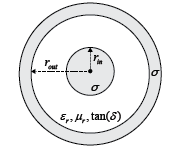txlineCoaxial
Create coaxial transmission line
Description
Use the txlineCoaxial object to create a coaxial transmission
line. A cross-section of a coaxial transmission line is shown in this figure. The physical
characteristics of a coaxial transmission line include the radius of the inner conductor,
rin and the radius of the outer conductor,
rout.

Creation
Description
coaxialtxline = txlineCoaxial
coaxialtxline = txlineCoaxial(Name,Value)txline =
txlineCoaxial('OuterRadius',0.0046) creates a coaxial transmission line with
an outer radius of 0.0046 meters.
Properties
Object Functions
sparameters | Calculate S-parameters for RF data, network, circuit, and matching network objects |
groupdelay | Group delay of S-parameter object or RF filter object or RF Toolbox circuit object |
noisefigure | Calculate noise figure of transmission lines, series RLC, and shunt RLC circuits |
getZ0 | Calculate characteristic impedance with and without dispersion for transmission line |
circuit | Circuit object |
clone | Create copy of existing circuit element or circuit object |